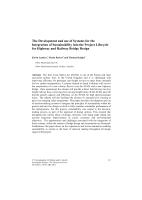Bridges

- Publication no: ABC-AMM007-11
- Published: 31 October 2011
- PDF (free) Download
The East Coast Main Line (ECML) is one of the busiest and most successful railway lines in the United Kingdom and it is challenged with improving efficiency for passenger and freight services to meet future demands for low carbon transportation. A scheme located in South Yorkshire will involve the construction of a new railway flyover over the ECML and a new highway bridge. Once operational, the scheme will provide a direct link between two key freight railway lines, removing slow moving freight trains off the ECML and will provide greater capacity and efficiency on the ECML for high speed passenger trains. The scheme will also facilitate the closure of a manned level crossing as part of an ongoing safety programme. This paper describes development and use of decision-making systems to integrate the principles of sustainability within the project and how the design evolved to fully consider sustainable performance of the infrastructure. For this project, sustainability was central to the decision-making process as part of the appraisal of design options. This ensured that throughout the earliest phase of design, decisions were being made taking into account long-term improvements in social, economic and environmental objectives. The opportunities and challenges associated with the integration of these systems, within the context of bridge design and construction are discussed. Furthermore, this paper draws on the experiences and lessons learned in enabling sustainability to remain at the heart of decision making throughout all design stages of the project.
